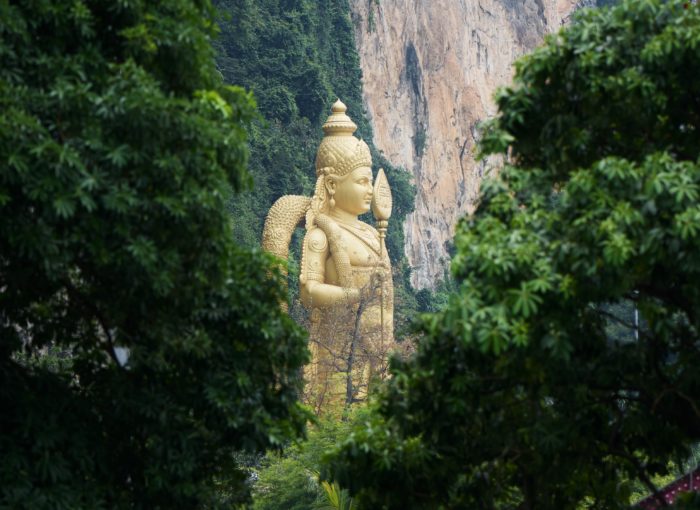Less than an hour away from the mighty skyscrapers of Kuala Lumpur, Batu Caves is the adobe of Malaysian Hinduism and one of the top destination in Malaysia. Batu Caves is named after the Sangai Batu river, which flows past the hill. The topographic beauty and the spirituality of the place enchant the visitors around the world. The 400 million-year-old limestone mountains are home to hundreds of species of flora and fauna.
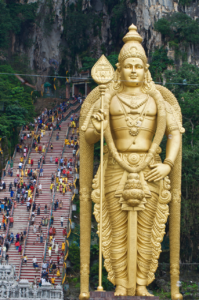
Our trip to Batu caves was on a Saturday, the second day during our four-day visit to Kuala Lumpur in January 2018. Being the main weekend destination for tourists and pilgrims alike, a moderate to a heavy crowd was expected. The most convenient mode of travel is by train. The KTM Commuter Line connects KL-central, the central hub of Kuala Lumpur metro network, with the Batu Caves Station.
As the train picks up speed, it was fascinating to watch the slow transition of the landscape from the Urban neighborhood to a greenish tropical rural panorama. In forty minutes the train pulled onto the Batu caves Station. More than the beauty of the Limestone Rocks carpeted in green, what caught my eye, was the imposing golden statue of Lord Kartikeya.The 140 feet high monument is the tallest Subramanya Statue in the world.
The station corridor ends at the line of street hawkers and souvenir shops beside the walkway to the main caves. The place resembled a South Indian village fair. Tamil devotional songs and Ilayaraja Melodies greeted us in the walkway. The eminent statues of Vedic characters, the architecture, the Tamil tunes and the scents from the street shops reminded the famous temples of TamilNadu and Kerala. We bought two bottles of cold water from an old lady for 2 Ringgits. The two hundred odd steps and rest of the walk that follows will test and dehydrate the body. So I will advise the same to anybody traveling to Batu Caves
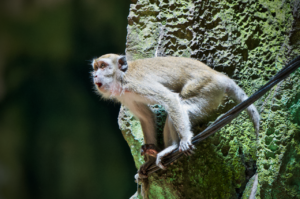
The 100-meter long walkway ends at the main central ground which is surrounded by small temples and shops. The 43 meter tallKartikeya Statue was towering skywards over the ground, guarding the flight of steps to the Cathedral Cave. The statue will remind you of the epic Indian movie, ‘Bahubali’. The red and white painting of the 270 steps behind the mammoth statue and beneath the main cave entrance created an interesting texture. The scene evoked mixed feelings of an odd fusion of nature’s craftwork improvised by the handy work of man. A delicate and subtle intrusion into nature
We started climbing the steps. The caves and surroundings are home to hundreds of monkeys and you will see them everywhere. It will be wise to avoid them and be careful with your belongings. We moved slowly, pausing after every 30 or 40 steps, panting and wiping the sweat, sipping water and resuming after a few minutes break. There were pilgrims swiftly striding up the steps with ‘Kavadi’ in shoulders and driven by faith. We envied at them. The ‘Kavadi’ is the main offering here.
Cathedral Cave
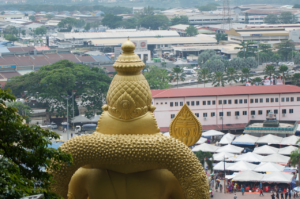
The view of the city of Kuala Lumpur from the top is awe-inspiring. You could see the twin towers of Petronas, the KL Menara and the entire stretch of the south-east Asian capital in the horizon.
The cold water from the small streams, atop the cave entrance, keeps the ground wet, for the tired feet after the steep climb. There is a temple of Lord Anjaneya ( Hanuman) at the entrance. The sunlight coming in from the top and shadows of the uneven rough edges created an intricate pattern of light and shade inside the cave. 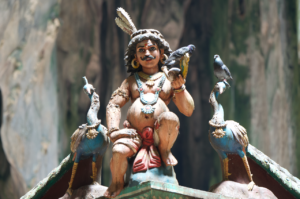 The chattering of monkeys and the chirping of pigeons echoed in the wet limestone walls. The chanting of prayers and temple bells complimented this. The feeling was surreal.
The chattering of monkeys and the chirping of pigeons echoed in the wet limestone walls. The chanting of prayers and temple bells complimented this. The feeling was surreal.
The cave extended to a raised inner platform which is 50 steps high. The inner cave houses the main temple which is an interesting mixture of Malayan and Indian architecture. A large troop of Monkeys, pigeons, bats and many other species lives inside this cave. They appeared to be in harmony or indifferent to the usual crowd of tourists and pilgrims. After the prayers, we sat on the ground, relaxed and lost in the serenity and beauty of the place.
Dark Cave
We started back after half an hour. On the way down, I purchased couple of small souvenirs from the shop at the entrance of thecathedral cave. There is a detour, after a few steps down from the top to another cave called the ‘dark cave’. The 850-meter long cave is home to several hundred life forms. It is a must visit place for the natural science students and nature lovers. Considering the rush at the entrance, we skipped this one and left it for some other time.
Ramayana Cave
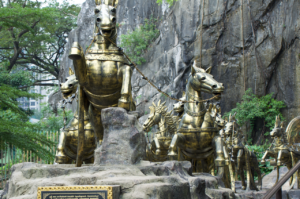 Adjacent to the base of the main hill lies the ‘Ramayana Cave’ which is equally worth exploring. The path to the cave starts near a giant statue of Lord Hanuman. A magnificent statue of Lord Krishna in a chariot pulled by a team of horses decorated the entrance. This remarkable artwork in the backdrop of the hill was adding an ethereal feel to the cave entrance.
Adjacent to the base of the main hill lies the ‘Ramayana Cave’ which is equally worth exploring. The path to the cave starts near a giant statue of Lord Hanuman. A magnificent statue of Lord Krishna in a chariot pulled by a team of horses decorated the entrance. This remarkable artwork in the backdrop of the hill was adding an ethereal feel to the cave entrance.
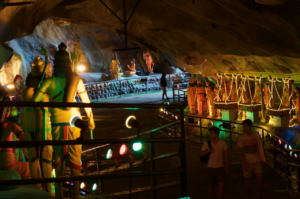
The illumination inside the cave is beautiful. The statues, of the key events in Ramayana, arranged in chronological order, narrates the central story.I gave a full narrative of the Ramayana connecting each of the statues to my Syrian friend, a history lover. The richness of plots and subplots, character descriptions and the interconnections in the Great Indian epic genuinely impressed him. I decided to save the Mahabaratha Story for him for another day. While we waited for the train back to Kuala Lumpur, we started planning for the seafood dinner in Bukit Bintang.
